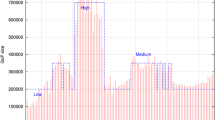Abstract
We investigate a variety of known and new approaches for the estimation of the parameters of discrete-time semi-Markovian traffic models. We focus on modeling video traffic, since the accurate representation of its long-term autocorrelation is a challenge to the parameter estimation methods. The modeling techniques are applied to sample H.264/AVC-encoded video traces. We study their ability to reflect the autocorrelation and variability of the original traffic and also the delay probabilities of a resulting SMP/GI/1 queueing system. The delay probabilities are determined both by simulation and verified analysis of the queue.
Similar content being viewed by others
References
Baey, S. (2004). Modeling MPEG4 video traffic based on a customization of the DBMAP. In Proceedings of the 2004 symposium on performance evaluation of computer telecommunication systems.
Borsos, T. (2001). A practical model for VBR video traffic with applications. In LNCS: Vol. 2216. MMNS 2001 (pp. 85–95). Berlin: Springer
Cerny, V. (1985). A thermodynamical approach to the travelling salesman problem: An efficient simulation algorithm. Journal of Optimization Theory and Applications, 45, 41–51.
Doulamis, N. D., Doulamis, A. D., Konstantoulakis, G. E., & Stassinopoulos, G. I. (2000). Efficient modeling of MPEG-1 coded video sources. IEEE Transactions on Circuits and Systems for Video Technology, 10(4), 99–112.
Feldmann, A., & Whitt, W. (1998). Fitting mixtures of exponentials to long-tail distributions to analyze network performance models. Performance Evaluation, 31, 245–279.
Gao, P., Wittevrongel, S., & Bruneel, H. (2004). Discrete-time multiserver queues with geometric service times. Computers and Operations Research, 31(1), 81–99.
Goldberg, D. E. (1989). Genetic algorithms in search, optimization and machine learning. Dordrecht: Kluwer Academic.
Haßlinger, G. (1997). Semi-Markovian modelling and performance analysis of variable rate traffic in ATM networks. Telecommunication Systems, 7, 281–298.
Hasslinger, G. (2000). Waiting times, busy periods and output models of a server analyzed via Wiener-Hopf factorization. Performance Evaluation, 40, 3–26.
Hasslinger, G., & Takes, P. (2003). Real time video traffic characteristics and dimensioning regarding QoS demands. In Proceedings of the 18th international teletraffic congress.
Kalva, H. (2006). The H.264 video coding standard. IEEE MultiMedia, 13(4), 86–90.
Kempken, S., & Luther, W. (2008). Verified methods in stochastic traffic modeling. In P. Hertling, C. M. Hoffmann, W. Luther, & N. Revol (Eds.), LNCS : Vol. 5045. Reliable Implementation of real number algorithms: Theory and practice (pp. 84–102). Berlin: Springer.
Kempken, S., & Luther, W. (2007). Modeling of H.264 high definition video traffic using discrete-time semi-Markov processes. In Proceedings of the 20th ITC (pp. 42–53).
Kempken, S., Luther, W., & Haßlinger, G. (2006). A tool for verified analysis of transient and steady states of queues. In Proceedings of the first international conference on performance evaluation methodologies and tools (VALUETOOLS ’06). Electronic resource.
Kempken, S., Luther, W., & Traczinski, D. (2006 ). Reliable computation of workload distributions using semi-Markov processes. In Proceedings of the 13th international conference on analytical and stochastic modelling techniques and applications.
Kempken, S., Luther, W., & Hasslinger, G. (2007). Parameter estimation for semi-Markov models for mobile video traffic. In Proceedings of analytical and stochastic modelling techniques and applications (ASMTA).
Kirkpatrick, S., Gelatt, C. D., & Vecchi, M. P. (1983). Optimization by simulated annealing. Science, 220(4598), 671–680.
Kleinrock, L. (1975). Queueing systems (Vols. 1/2). New York: Wiley.
Krunz, M., & Ramasamy, A. M. (2000). The correlation structure for a class of scene-based video models and its impact on the dimensioning of video buffers. IEEE Transactions on Multimedia, 2(1), 27–36.
Kundu, D. (2004). Computational aspects in statistical signal processing. In D. Kundu & A. Basu (Eds.), Statistical computing: existing methods and recent developments (pp. 371–393).
Latouche, G., & Ramasvami, V. (1999). Introduction to matrix analytic methods in stochastic modeling. ASA-SIAM.
Li, S. Q. (1991). A general solution technique for discrete queueing analysis of multi-media traffic on ATM. IEEE Transactions on Communication, 39, 1115–1132.
Panchenko, A., & Buchholz, P. (2007). A hybrid algorithm for parameter fitting of Markovian arrival processes. In Proceedings of ASMTA (pp. 7–12).
Rose, O. (1997). Simple and efficient models for variable bit rate MPEG video traffic. Performance Evaluation, 30, 69–85.
Rose, O. (1999). A memory Markov chain for VBR traffic with strong positive correlations. In Proceedings of the 16th ITC (pp. 827–836).
Salvador, P., Valadas, R., & Pacheco, A. (2003). Multiscale fitting procedure using Markov modulated Poisson processes. Telecommunications Systems, 23(1–2):123–148.
Seeling, P., Fitzek, F., & Reisslein, M. (2007). Video traces for network performance evaluation. Berlin: Springer.
Traczinski, D. (2006). Faktorisierungslösungen für die Workload in Bediensystemen mit Ergebnisverifikation. PhD thesis, Universität Duisburg-Essen. Logos.
Whitley, D. (1994). A genetic algorithm tutorial. Statistics and Computing, 4(2).
Zitzler, E., Laumanns, M., & Thiele, L. (2001). SPEA2: Improving the strength Pareto evolutionary algorithm (Technical Report 103). Computer Engineering and Networks Lab (TIK), ETH Zurich.
Author information
Authors and Affiliations
Corresponding author
Rights and permissions
About this article
Cite this article
Kempken, S., Hasslinger, G. & Luther, W. Parameter estimation and optimization techniques for discrete-time semi-Markov models of H.264/AVC video traffic. Telecommun Syst 39, 77–90 (2008). https://doi.org/10.1007/s11235-008-9113-1
Published:
Issue Date:
DOI: https://doi.org/10.1007/s11235-008-9113-1




